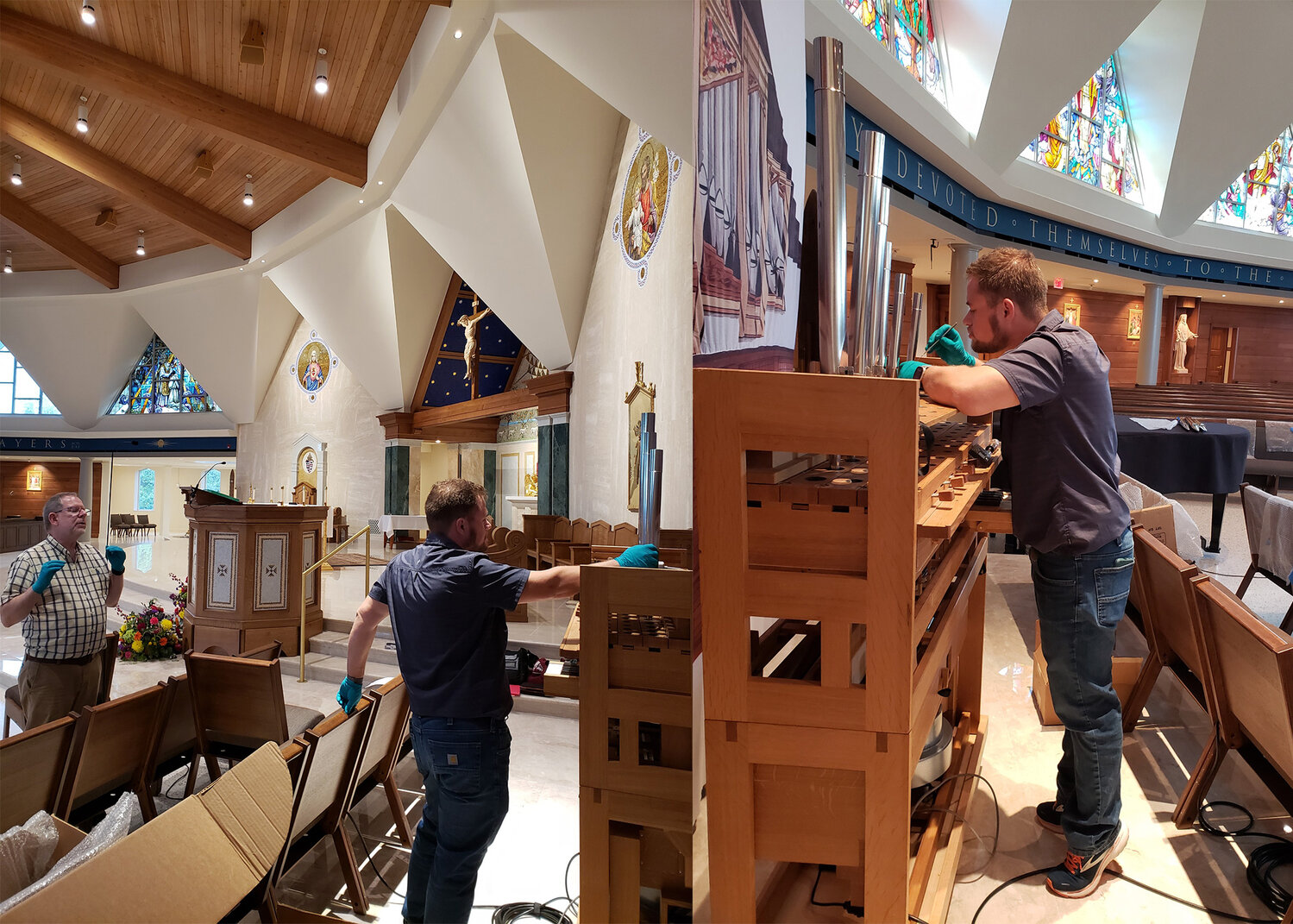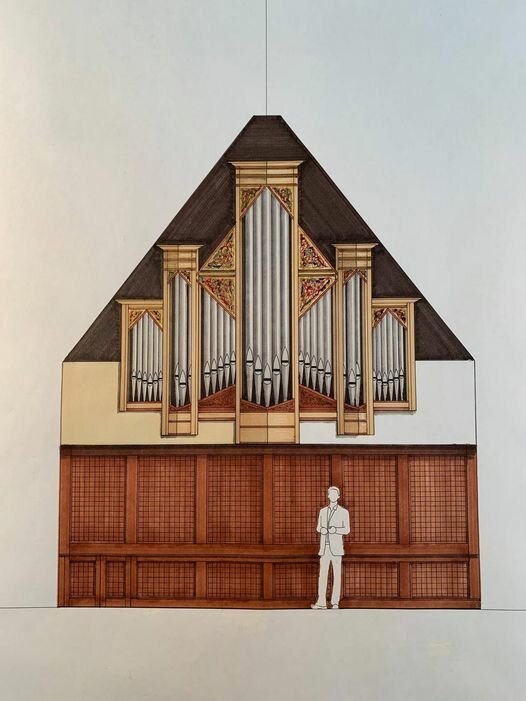Voicing continues on pipes for new organ for Cathedral
Scheduled to be installed in early 2024

The foundational voices of a new organ have been matched to the acoustics of the Cathedral of St. Joseph in Jefferson City.
This important step will ensure that all the pipes being created for the organ will speak and reverberate with the greatest effectiveness possible.
“The end result, we trust and pray, will be an instrument that draws people into greater communion with God and one another, as they lift up their voices to him,” said Father Jeremy Secrist.
Fr. Secrist, pastor of neighboring St. Peter Parish in Jefferson City, is also the diocese’s moderator for pipe organs.
He was present the afternoon of July 26, when selected pipes from the 8- and 4-foot Principal ranks in the Great, Swell and Pedal divisions were set up on wind chests inside the Cathedral.
Technicians with the Buzard Organ Company of Champaign, Illinois, sent air through the pipes, taking careful measurements and adjusting each pipe to produce its proper tones.
Principal pipes are the foundation of any church organ and give the instrument its recognizably “churchy” sound.
“These pipes of various pitches, from various divisions — and hence, of various wind pressures — will be taken back to the shop, and the other 2,300 other pipes will be voiced from them,” said Fr. Secrist.
The art and science of “voicing” organ pipes draws on centuries of acquired knowledge about how the size, shape and composition of each pipe, coupled with the pressure of the air blowing through it and the space into which it speaks, affects the character of the entire instrument.
“For the human ear,” he noted, “there are harmonic interactions that occur at particular pitches that actually bring about something greater.”
“It’s like the Gestalt Theory, that the whole is greater than the sum of its parts,” he said.
He asserted that a pipe organ is the most like the human voice of any instrument in singing the Lord’s praises.
Like voices in a choir, each set of pipes speaks at different pitches, with different voices, at different volume and different texture.
Together, they produce an overall effect that is richer and more uplifting than any of the voices singing alone.
“That’s the principle behind how a good and effective pipe organ speaks,” Fr. Secrist stated. “It’s not just a bunch of beautifully voiced pipes. Rather, the whole ensemble functions well together.”
Good vibrations
The Cathedral’s new organ will occupy the same space as the previous one, but the Cathedral itself, recently renovated, is substantially different, with many new materials that enhance its acoustics and bring greater depth to all sung and instrumental music.
Like most systems in the pre-renovated Cathedral, the previous organ, built in 1968, was wearing out and needed to be replaced.
The blower and wind chests for forcing pressurized air into the pipes were deteriorating, as were some of the pipes themselves.
In addition, because of the instrument’s tonal qualities and the building’s dry acoustics, the voices never mixed properly.
The new organ will have more voices — 40 ranks of pipes versus 31 — most of which will project into the Cathedral from high above the choir members’ heads.
Many of the various sets of pipes will be enclosed in chambers. The organist will be able to adjust the volume at which those pipes are heard by opening and closing swell shades on the front of the chambers, using a pedal on the console.
This arrangement, known as “expression,” multiplies the possibilities for mixing the organ’s voices and creating appropriate tonal effects for whatever kind of music is being played.
The new pipes and the complex systems that will make them speak are being built to last for generations.
“We’re laying the foundation for people still to be praising and worshiping here long after we’ve all gone to meet God,” Fr. Secrist stated.
“Greater artistic expression”
The completed organ is scheduled to be installed early next year.
An electronic instrument is being used in the interim.
Fr. Secrist is convinced that a custom-designed, properly-built, appropriately voiced pipe organ is worth the cost.
“In some situations, you have a greater need for austerity and simplicity,” he noted.
“But in other situations,” he said, “including the mother church of a diocese, where Liturgies are regularly celebrated that draw people together from many parishes, you have the need for a greater artistic expression of the faith and the mysteries we celebrate.”
The Cathedral’s enhanced beauty on all fronts helps orient visitors and regular worshippers toward God and assists them in their desire to grow in relationship with Him.
That objective, Fr. Secrist stated, is why “Sacrosanctum Concilium,” the Church’s Constitution on the Sacred Liturgy promulgated by Pope St. Paul during the Second Vatican Council, states:
“In the Latin Church, the pipe organ is to be held in high esteem, for it is the traditional musical instrument which adds a wonderful splendor to the Church’s ceremonies and powerfully lifts up man’s mind to God and to higher things.” (#120)
“For hundreds of years within the life of the Church, the pipe organ has always proved to be an instrument that has accompanied, supported and inspired prayer within the people of God,” said Fr. Secrist.
Comments
Other items that may interest you
Services
The Catholic
Missourian
2207 W. Main St.
Jefferson City MO 65109-0914
(573) 635-9127
editor@diojeffcity.org







